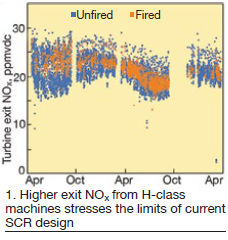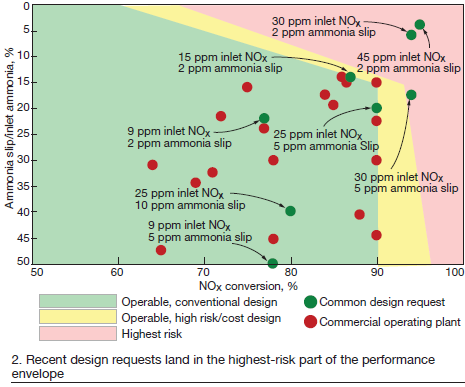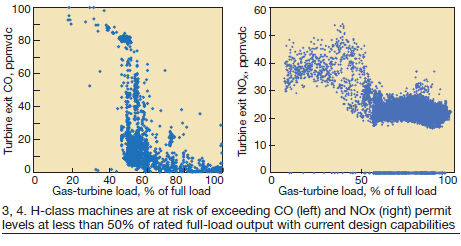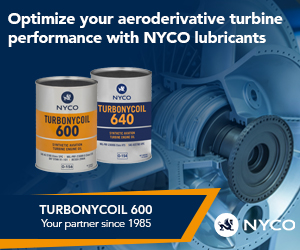The state-of-the-art gas turbines (GTs), such as the H-class and J-class machines, are designed to maximize fuel-to-electricity efficiency, achieving and even exceeding 60% in combined-cycle mode. Already, there are an impressive number of these machines in the field; one supplier listed 80+ H-class GTs operating, in commissioning, being installed, or on order.
This achievement is accomplished through increased firing temperatures, upgraded combustion staging, and advanced metallurgy. The tradeoff to higher temperature, of course, is increased thermal-NOx formation. Dan Ott, president, Environex Inc told the editors that the burden of turbine-exit NOx emissions ends up on the SCR system, at least to achieve the same stack emissions as specified for F-class sites.
Additionally, he said, these machines are being promoted for even faster starts, more frequent cycling, and operation at loads down to 20% compared to the 50%-to-baseload range historically required of earlier designs. Lower-load operation coupled with higher exhaust NOx levels present a demanding set of design challenges for the post-combustion NOx and CO catalyst systems.
Currently, gas-fired turbines often are required to achieve 2- to 2.5-ppmvdc stack NOx, 2- to 5-ppm ammonia slip, and CO limits of 1 to 6 ppm. These limits became a de facto standard, at least in the US, after they were demonstrated based on F-class and aeroderivative engines with typical turbine-exit NOx between 9 and 20 ppmvdc.
 The new H-class machines exhibit 25 to 30 ppmvdc NOx emissions (Fig 1) with some excursions above 35 ppmvdc. This is by no means a trivial increase, Ott stressed. The SCR system designs are going from 75% to 85% NOx removal for F-class units to designs of 92% to 94% removal efficiency for the new advanced turbines. Higher conversion rates mean more catalyst, more frequent catalyst replacement, far more elaborate ammonia injection grids, and more frequent tuning.
The new H-class machines exhibit 25 to 30 ppmvdc NOx emissions (Fig 1) with some excursions above 35 ppmvdc. This is by no means a trivial increase, Ott stressed. The SCR system designs are going from 75% to 85% NOx removal for F-class units to designs of 92% to 94% removal efficiency for the new advanced turbines. Higher conversion rates mean more catalyst, more frequent catalyst replacement, far more elaborate ammonia injection grids, and more frequent tuning.
Equally important to the SCR design is the impact from the ammonia-slip limit. A Frame 7F turbine with dry-low-NOx technology and a turbine-exit NOx level of 9 ppmvdc can rather easily meet a 2-ppm NOx/2-ppm ammonia-slip limit with 78% NOx removal and allowance for 22% excess ammonia (2-ppm stack/9-ppm inlet = 22%). When the turbine-exit NOx increases to 30 ppm, a 2-ppm NOx/2-ppm ammonia-slip limit requires 93% NOx removal with only 7% excess ammonia.
The success of the SCR design is critically dependent on the amount of excess ammonia that can be injected. Systems should be designed for greater excess ammonia at higher NOx removal requirements, Ott said, but the regulations currently do not allow this.
Fig 2 compares designs with different NOx-removal and excess-ammonia allowances, taking into account the complexity and operability of the designs. Note that most of the newest, higher-efficiency designs are in the “highest risk” zone where the risk of failure on commissioning is high and maintenance (catalyst replacement, catalyst cleaning, and ammonia tuning) is frequent and costly.

All turbines, including the newest designs, are now required operate at low and variable loads to respond to dynamic grid demands. This is in due in part to the growing impact of renewable power. Output down to 20% load is not uncommon.
Figs 3 and 4 show real-time operating data for NOx and CO emissions versus load for an advanced-class turbine. Most low-NOx/low-CO combustor technology is designed to function within guaranteed limits for NOx and CO above 50% load. Below that, NOx and CO increase rapidly because of suboptimal fuel/air mixing. These spikes in emissions at low load require the SCR and CO catalyst systems to achieve emissions reductions as high as 98%, far exceeding the capability of most designs.

Ott’s conclusions: “We have reached the limit of current SCR and CO catalyst technology. We must increase awareness of these issues and look for broader solutions, including modified hardware and regulatory relief, to allow these new turbines to perform as required in an increasingly dynamic and unpredictable energy market.”





